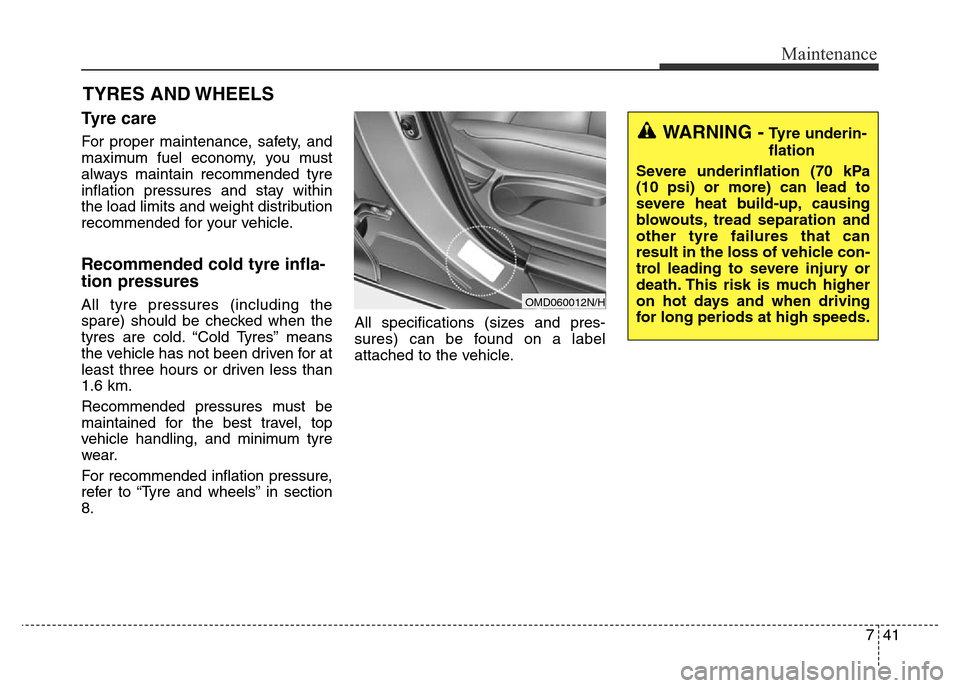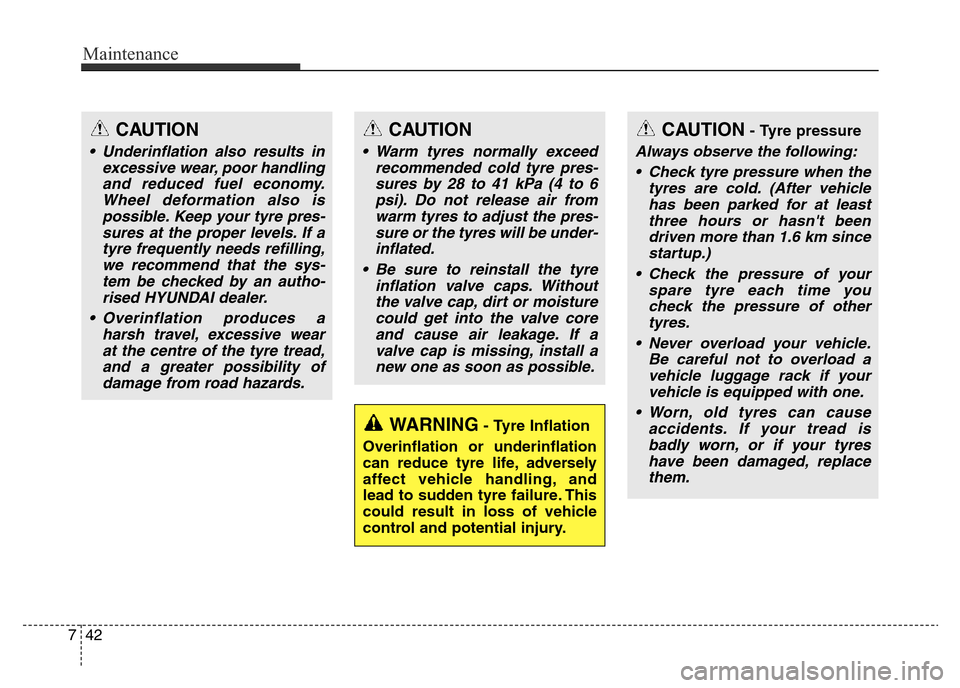Page 411 of 498
Maintenance
16 7
NORMAL MAINTENANCE SCHEDULE (CONT.)
(Continued)
❑ Inspect tyre (pressure & tread wear)
❑ Inspect manual transaxle fluid (if equipped) *8
❑ Inspect vapour hose and fuel filler cap
❑ Inspect vacuum hose
❑ Inspect cooling system
(At first, 60,000 km or 48months
after that, every 30,000 km or 24months)
❑ Replace climate control air filter (if equipped)
❑ Replace engine oil and filter *2
❑ Replace fuel filter *3
❑ Replace fuel tank air filter
❑ Replace spark plugs (Every 160,000 km)
❑ Replace coolant *5 *6
(At first, 210,000 km or 120months
after that, every 30,000 km or 24months)
No check, No service required
❑Automatic transaxle fluid (if equipped)
❈Inspect : Inspect and if necessary, adjust, correct, clean or
replace.
Page 436 of 498

741
Maintenance
TYRES AND WHEELS
Tyre care
For proper maintenance, safety, and
maximum fuel economy, you must
always maintain recommended tyre
inflation pressures and stay within
the load limits and weight distribution
recommended for your vehicle.
Recommended cold tyre infla-
tion pressures
All tyre pressures (including the
spare) should be checked when the
tyres are cold. “Cold Tyres” means
the vehicle has not been driven for at
least three hours or driven less than
1.6 km.
Recommended pressures must be
maintained for the best travel, top
vehicle handling, and minimum tyre
wear.
For recommended inflation pressure,
refer to “Tyre and wheels” in section
8.All specifications (sizes and pres-
sures) can be found on a label
attached to the vehicle.
WARNING -Tyre underin-
flation
Severe underinflation (70 kPa
(10 psi) or more) can lead to
severe heat build-up, causing
blowouts, tread separation and
other tyre failures that can
result in the loss of vehicle con-
trol leading to severe injury or
death. This risk is much higher
on hot days and when driving
for long periods at high speeds.
OMD060012N/H
Page 437 of 498

Maintenance
42 7
WARNING- Tyre Inflation
Overinflation or underinflation
can reduce tyre life, adversely
affect vehicle handling, and
lead to sudden tyre failure. This
could result in loss of vehicle
control and potential injury.
CAUTION- Tyre pressure
Always observe the following:
• Check tyre pressure when the
tyres are cold. (After vehicle
has been parked for at least
three hours or hasn't been
driven more than 1.6 km since
startup.)
• Check the pressure of your
spare tyre each time you
check the pressure of other
tyres.
• Never overload your vehicle.
Be careful not to overload a
vehicle luggage rack if your
vehicle is equipped with one.
• Worn, old tyres can cause
accidents. If your tread is
badly worn, or if your tyres
have been damaged, replace
them.
CAUTION
• Warm tyres normally exceed
recommended cold tyre pres-
sures by 28 to 41 kPa (4 to 6
psi). Do not release air from
warm tyres to adjust the pres-
sure or the tyres will be under-
inflated.
• Be sure to reinstall the tyre
inflation valve caps. Without
the valve cap, dirt or moisture
could get into the valve core
and cause air leakage. If a
valve cap is missing, install a
new one as soon as possible.
CAUTION
• Underinflation also results in
excessive wear, poor handling
and reduced fuel economy.
Wheel deformation also is
possible. Keep your tyre pres-
sures at the proper levels. If a
tyre frequently needs refilling,
we recommend that the sys-
tem be checked by an autho-
rised HYUNDAI dealer.
• Overinflation produces a
harsh travel, excessive wear
at the centre of the tyre tread,
and a greater possibility of
damage from road hazards.